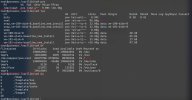I have been trying to make sense of what these terms actually mean, and how they relate to each other.
I just got my Proxmox VE up and running and started loading in ISO's when I started getting "no space available" messages (ridiculous, I have 10 TB...)
So now I'm trying to understand what I need to do to resize my disks correctly, but I can't seem to make sense of the terms.
Do these terms stack like nesting dolls?
I'm understanding that I need a non-thin LVM (I think) to store my ISO's on, and I think it needs to be a directory?
I think I'd like to try and partition/logically separate a few major items.
1. ISO's
2. Backups & Snapshots
3. Proxmox OS files
4. Containers & Image files
Is this a reasonable way to split out my files? If not, can you explain why? If it is reasonable, can you give an example of what that might look like?
Any explanations would be very much appreciated, I'm definitely missing something that must be considered implicit in the documentation
Here's a snip of output, I decided to just go ahead and clean the root drive for now, and re-copy the ISO's when I've fixed the volume issue.

I just got my Proxmox VE up and running and started loading in ISO's when I started getting "no space available" messages (ridiculous, I have 10 TB...)
So now I'm trying to understand what I need to do to resize my disks correctly, but I can't seem to make sense of the terms.
Do these terms stack like nesting dolls?
I'm understanding that I need a non-thin LVM (I think) to store my ISO's on, and I think it needs to be a directory?
I think I'd like to try and partition/logically separate a few major items.
1. ISO's
2. Backups & Snapshots
3. Proxmox OS files
4. Containers & Image files
Is this a reasonable way to split out my files? If not, can you explain why? If it is reasonable, can you give an example of what that might look like?
Any explanations would be very much appreciated, I'm definitely missing something that must be considered implicit in the documentation
Here's a snip of output, I decided to just go ahead and clean the root drive for now, and re-copy the ISO's when I've fixed the volume issue.


